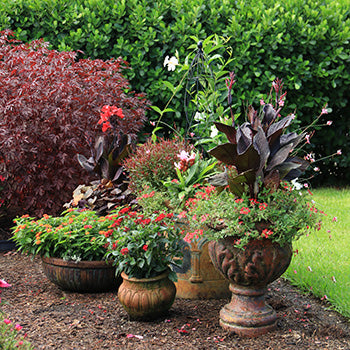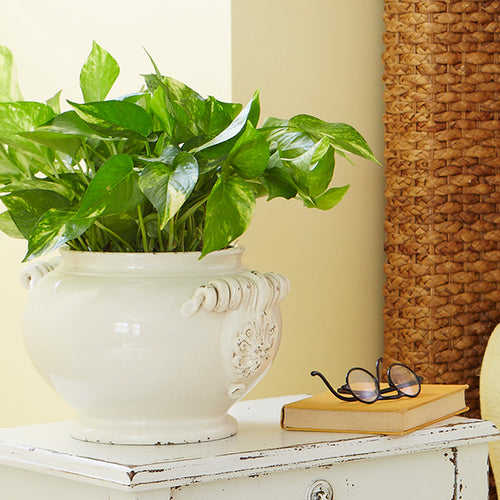Begonias are some of the most versatile plants around -- there’s a variety for practically everyone, whether you garden indoors or out or have sun or shade. But it’s important to pick the right kind of begonia for success. Here’s what to look for in begonias -- including tips to selecting the best plants at your local garden center.

Wax Begonias
Wax begonias, also called bedding begonias or semperflorens types, are among the easiest -- and common -- of all
varieties to grow outdoors. Most are tidy, mounding plants that have cheery little blooms in shades of red, pink, and
white. You can commonly find varieties with bronze-flushed foliage, as well as types with adorable, rose-like double
blooms. One of the best things about wax begonias is that they grow well in sun or shade and thrive equally well in
landscape beds and borders as they do containers. Most wax begonias stay a foot tall or less and bloom nonstop all
spring, summer, and fall. Common varieties include the Ambassador series, Cocktail series (such as Cocktail Whisky),
Doublet series (which have double flowers), and Olympia series.

Interspecific Begonias
Interspecific begonias look like wax begonias on steroids. These plants are much larger, and have bigger blooms, as
well. Most interspecific varieties flower in shades red, pink, and white, and continue to do so until frost. Happily,
like their little siblings, they grow well in both sun and shade (though you get more flowers in the sun). Because
they're so easy to grow, they're perfect for gardeners of any skill level -- including beginners. Common varieties
include the Big series, Dragonwing series, and Whopper series. They’re standouts in garden planting beds, as well as
containers. Their large size makes them ideal showpiece plants in pots by themselves or with other smaller
varieties.

Boliviensis Begonias
Relatively new to most gardeners, boliviensis begonias are bred from a wild species (Begonia boliviensis). This species
is noted for growing on cliff walls in South America. These varieties offer smallish, pendulous flowers that hang from
stems like fancy earrings (but in profusion). Shades of orange and red flowers are most common, but plant breeders have
brought us types that have pinkish, white, and yellow-toned flowers as well. Boliviensis begonias are particularly well
suited to container gardens such as hanging baskets where they can be viewed from straight on or below. Most grow in sun
or shade. Bonfire, BossaNova, and Santa Cruz are common varieties.

Reiger Begonias
Reiger begonias are showier than wax or interspecific types, but are also a little fussier in their care. Commonly sold
as indoor plants, they prefer cool temperatures and are most commonly available in winter and early spring. Indoors
they’re usually considered short-lived gift plants rather than long-lived houseplants. Outdoors, they’re magnificent in
hanging baskets and window boxes in regions with cool summers or as early-spring container plants in warmer regions.
Most have double, rose-like flowers and thrive in part shade. Reiger begonias are available in a wide range of colors,
including shades of yellow and orange. We've found the Solenia collection to be particularly durable, even in direct
sun.

Tuberous Begonias
Tuberous begonias are among the most dramatic of all begonias, bearing large, double flowers that are sometimes
delightfully fragrant. Like reiger begonias, the tuberous types thrive in cool conditions and tend to sulk in especially
hot-summer areas. They do best in situations with shade or morning sun/afternoon shade. Most varieties have flowers that
hang down a little, making tuberous begonias ideal for hanging baskets and window boxes rather than garden beds and
borders. No matter where you grow them, make sure they have good drainage to prevent rot. Add extra interest to your
outdoor space by selecting varieties such as the Nonstop Mocca collection, which feature dark leaves that accent the
bright blooms.

Rex Begonias
Unlike the begonias we’ve just talked about, Rex begonias are
grown for their fantastic foliage. They don’t like especially hot temperatures, so you often see Rex begonias as
easy-care houseplants, though they also make for great garden and container plants in cool-summer areas. Most Rex
begonias bear leaves boldly variegated with shades of silver, pink, purple, red, or bronze.
Rhizomatous Begonias
Rhizomatous begonias are also grown for their foliage and many varieties resemble Rex types. The rhizomatous types we
grow feature bigger leaves and easier care needs. They grow well outdoors in shaded areas, even in hot-summer
areas. Picking Begonias
When shopping for begonias at your local garden center, look for plants that have lush, healthy leaves. Yellowing or
browning of the foliage often represents a problem. Most types are sensitive to being watered too much and will sulk if
they’re kept too wet. If you’re in doubt about a begonia’s health, don’t be afraid to slip it out of the pot to examine the roots. Healthy begonia roots should be white and firm rather than yellow or brown and mushy. Also look to see if the plant is rootbound, with roots densely filling the soil and circling around the inside of the pot. Rootbound begonias are often stressed and may not be as healthy.
Don’t be alarmed if the begonias aren’t blooming, particularly the tuberous types, which have brittle flowers. The plants may be perfectly healthy, even if they don’t have any blooms on them.
Caring for Begonias Outdoors
Make sure you match the lighting conditions with the type of begonia you have. In most areas, for example, tuberous
begonias will suffer sunburn and look bad in full-sun areas. Also pay attention to the soil or potting mix -- they like
a well-draining medium and hate to have their roots stay wet for extended periods. It’s much easier to kill a begonia by
watering it too much than not enough. Most begonias grow just as well in containers as they do garden beds and borders. They are particularly effective plants for creating a unified look in your yard because you can grow many varieties in both sun and shade. Repeating beautiful begonias in containers and garden beds also creates a consistent landscaping look.
Caring for Begonias Indoors
Houseplant-type begonias, such as the Rex varieties, are relatively easy-to-grow indoor plants for medium to bright
spots. Avoid keeping Rex begonias in a window that sees a lot of direct sun in the afternoon, particularly in the summer
months as they are susceptible to sunburn. To water begonias indoors, let the top inch or so of the potting mix dry before watering it again. Take care not to overwater Rex begonias. Repotting is typically necessary once every couple of years.
Related
A Shopper's Guide to
Outdoor FernsA Shopper's Guide to Geraniums
A Shopper's Guide to Hibiscus

















